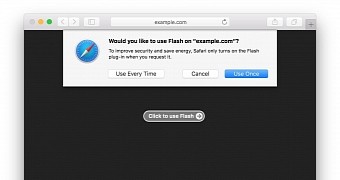Tech companies are one by one giving up on Flash Player because of the issues that it leads to, be they performance- or security-related problems, and Apple is the latest name taking a bold step in the same direction.
Cupertino has announced that, starting with Safari 10 in macOS Sierra, Flash will be disabled by default and will attempt to load the HTML5 version of each website should it exist.
But because Flash continues to remain widely popular across the web, Safari 10 will allow users to manually enable Flash content they discover online, either for each component or across the entire website. An option to enable specific Flash content every time the user visits that website will also be offered, but otherwise, this only happens temporarily, so upon browser restart, the default settings will come into play and keep Flash disabled by default.
“Whenever a user enables a plug-in on a website, it’ll remain enabled as long as the user regularly visits the website and website still uses the plug-in. More specifically, Safari expires a user’s request to activate a plug-in on a particular website after it hasn’t seen that plug-in used on that site for a little over a month,” Apple explains.
More secure browsing
Obviously, Apple recommends developers to look for alternatives to Flash Player, and the most popular remains the HTML5 implementation.
But as far as users are concerned, this should lead to a more secure, faster, and more stable browsing experience, especially when considering the number of bugs that Flash Player has experienced in the last couple of years.
“On websites that offer both Flash and HTML5 implementations of content, Safari users will now always experience the modern HTML5 implementation, delivering improved performance and battery life,” Apple explains.
In 2015, Adobe fixed a total of 316 security vulnerabilities in Flash Player, so it’s no surprise that more companies are trying to step away from it these days. Right now, for example, Adobe is working to address a critical Flash Player flaw that’s already being exploited in the wild and that exposes users to attacks that could eventually give cybercriminals full control of the vulnerable system. A patch is expected on Thursday, June 16.

 14 DAY TRIAL //
14 DAY TRIAL //